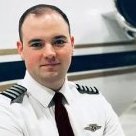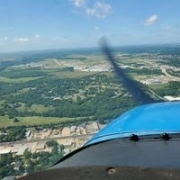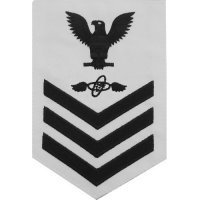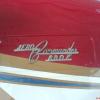
-
Content Count
284 -
Donations
$0.00 -
Joined
-
Last visited
Community Reputation
117 ExcellentAbout capceo
-
Rank
Member
Profile Information
-
Gender
Male
-
Location
KTEB and KMGJ
Flight Sim Profile
-
Commercial Member
No
-
Online Flight Organization Membership
VATSIM
-
Virtual Airlines
Yes
Recent Profile Visitors
1,870 profile views
-
Thanks! I've been crazy busy flying the jet, and when I do have a reason to fly the 414, I just get lazy and don't bring the cameras. I'll get off my rear end and do another soon.
-

*PICS* Cessna 414AW Development Update
capceo replied to capceo's topic in Flysimware Reciprocating Aircraft
Never say never, but it wouldn't be possible to "upgrade" them in the sense you refer to. Each of those models was created in Gmax, whereas our newer offerings are all designed in 3DSmax. Ultimately, to bring the 441 and 402 up to the standard of the 414 would require, literally, re-doing them from scratch. -
Good Evening Everyone, The exterior model of the 414AW is complete, and has returned from the texture artists. There are a number of texture issues which need to be resolved before the exterior texturing is complete, but I couldn't help sharing these with all of you. This aircraft represents a SIGNIFICANT leap forward for Flysimware from a quality standpoint, and we think you'll all appreciate the direction our products are heading in. Welcome to the new direction of Flysimware! Enjoy. Feel free to click on the image to view full size.
-
That would, indeed, be my ride!
-
Just a quick blended image showing the behind the scenes detail of the Continental/RAM TSIO-520-NB that is fully modeled in our 414AW project! You'll be able to open the lower nacelles and see them for yourselves! Enjoy!
-
Sorry to hear you regret the purchase. All I can say is that this is, by far, the most complete and comprehensive representation of a 30 series Learjet available for a desktop flight simulator anywhere. Honestly, most of the time we have the batteries on long before the GPU is ever brought to the airplane. As for pulling the breaker to get rid of the EPV sound, that isn't how the system is designed in real life. The valve fails to OPEN in the absence of bleed air/vacuum. So if you pulled the breaker prior to engine start, it would fail OPEN which would mean the sound would never go away. The sound you hear on engine start is the valve closing, not the valve opening.
-
You're absolutely right about the GPU. Unfortunately, this is a bit of sim limitation. But yes, the GPU won't connect to the battery charging bus without at least one battery relay closed. You're also right about the EPV valve closing. Unfortunately, it's impossible to record an engine start that begins with the EPV already closed, so we just have to live with hearing it on both starts. It annoys me too, and I'm the one who created the sounds lol. Believe it or not, the 35 won't start over the gate. Ask me how I know. If you engage the starter with the thrust lever in idle, it will never light off. At that point, you can just move the thrust lever into cutoff, then right back up to idle, and the sequence will continue normally. Definitely a mistake I've only made once! The TR issue is also a sim limitation, but if you look closely, they actually aren't deploying. You'll get a quick flash of the DEPLOY light, but they don't actually come out.
-
I mean we're still doing six month 135 rides in the actual airplane, doing actual V1 cuts on the runway in a 30 series Learjet. FWIW, the 135.297 check requires two of the four approaches be coupled.
-
Sure. Despite the fact that it burns significantly more fuel than modern comparative airplanes, like the Embraer Phenom 300 (which I flew at my last job), its still a fantastic value. In fact, the LR35 and LR55 I fly are both executive charter airplanes. Look at the value proposition this way: If you want a jet that seats 8, cruises at M0.80, and has 2,000nm of range, 5hrs of endurance, and costs less than $2000hr to operate, what else are you going to buy for the same money? So, lets compare the LR35 to the modern day counterpart, the Phenom 300. The Lear 35 is burning 1400pph in cruise at M0.77. The Phenom is burning 800pph at M0.77. In other words, the Lear burns 208gph, and the E55P burns 119gph. Now lets assume we operate our airplane 300hrs per year. The Phenom saves you 89gph over the Lear 35, or 26,700 gallons per year. At an average retail price of $5.50/gal, that's an annual savings of $146,850. Sounds great! Right? Not so much. A 5 year old Phenom will cost you $7,000,000. A decent Lear 35 can be had for $500,000. So what does this all mean? It means that for the PURCHASE PRICE of a 5 year old Phenom 300, you could buy a decent Lear 35 and put fuel in it for 5,681hrs, or 300 hours per year for almost 19 years, before the total cost of the two airplanes was equal at $7,000,000. Obviously, this doesn't take into consideration maintenance, crews, insurance, hangars, etc. But the biggest two deltas between new and old is fuel and purchase price. This example shows why the older Lears are still popular, and still a great value. For the money it would take to buy a newer airplane with the same cabin and performance, you could buy a LR35 and run it for a long, long time.
-
1) I find that it doesn't take anywhere near that power to get the airplane moving in the sim. Something doesn't sound right here. Just like the real airplane, it should only require a bit of breakaway power, and then should taxi on idle, or slightly above idle thrust. As far as small engines go, the LR35 actually has enormous engines from a relative standpoint. 3500lbs of thrust per side. 7000lbs of thrust for an airplane with a maximum takeoff weight of 18,300lbs. 2) This is a tough one to answer. On the ground, the N1 idle speed is around 28-30%. ITT at idle depends on ambient temperature. At altitude, the fuel computer underspeed protection adjusts the minimum idle speed based on altitude. At 41,000ft, pulling the thrust levers to idle results in an idle N1 of around 75%. This is primarly done to ensure that there's enough bleed air to maintain the cabin. Unfortunately, we couldn't simulate this. 3) The Nose UP/DOWN switch on the pedestal won't do anything unless the pitch trim is in secondary mode. That little white toggle is a backup in the event the primary pitch trim stops working. In fact, part of the first flight of the day check is to make sure that switch DOES NOT work when the pitch trim selector is in primary. When in primary, the only way to trim the airplane is to use the trim hat on the yokes. Hope that helps.
-
To add my two cents, it's not that it's necessarily too much too ask, but it's important to remember the exorbitant amount of work that goes into something as "simple" as a texture revamp on an older product. For one, they were made using Gmax, which FSW has exclusively discontinued using, in favor of 3DSMax. This means that any remapping needed would have to be done in Gmax, where everything takes 10 times as long as it should. It would be extremely time consuming to bring these models into the new software. I've discussed it with Mark, but for starters, every animation needs to be redone from scratch. That alone is weeks worth of work. Keep in mind also, the Lear 35's refresh by Wickedbacon took every bit of three months, and he was working darn close to 12 hour days, sometimes more. If I had to guess, he took maybe 10 days off over the course of those 90 days. So what we're talking about is months worth of work by Wickedbacon, and a significant amount of work away from new projects by Mark to adjust mappings. Working a reasonable number of hours, refreshing the MU-2, the 441, and the 402 is a solid year of work for Wicked. I'd love to see the textures on these older products brought up to date just as much as you, and we may still see that happen. But it's an enormous undertaking.
-
Just as a notable mention, we actually gave several areas of the cockpit which do not have EL backlighting at night, backlighting in the sim. Things that would be basically impossible to find without it. For example, the rotary knobs for the panel lights don't have any lights at all in the real airplane (ironic). The flap gate also doesn't have EL backlighting in the real airplane, and neither do the oxygen control knobs.
-
Interesting. Next time I fly the 35, I'll take a pic of our MCT chart with the -2C engines and post it here. I worked today, but flew the LR55, and our LR35 is currently down for an inspection. If it makes you feel any better, our 35, which is the one we modeled the FSW off of, has N1 DEEC's, so every engine parameter is protected. When we apply takeoff power, we just push the power levers to the stops, and if N1, N2 or ITT limits are reached, the DEEC's will prevent them from being exceeded. This is also true at altitude. If you really need to, you can, at any time, firewall the thrust levers, and you'll never exceed a tolerance. (Provided the DEEC's are working correctly, and the fuel computers are ON and working normally.) I'm serious. If you're ever in the area, reach out. Time with the jets and lunch are on me.
-
First of all, I totally and completely applaud your study centered approach to flying this airplane. It’s commendable, and quite frankly, impressive. Having said that, here are a few of my thoughts. You’re doing the best you can with the performance charts in the AFM, but unless you’ve got the right charts for the optional equipment installed on the FSW LR35, the numbers won’t make sense. For example, the MCT chart is changed by the installation of the -2C engines, which will be reflected not by modifying the existing chart in the AFM, but instead by adding a supplement to the AFM. Same goes for just about every power related chart in the book. The “standard nozzle” chart, is for airplanes that DO NOT have thrust reversers. If you’ve got Dee Howard TR4000’s, like the FSW, all of your power setting charts are going to be in the thrust reverser supplement, not in the AFM. Totally different set of charts if you’ve got Aeronca TR’s. The nozzle parameters change when TR’s are installed, and so do the charts. I also noticed at one point you said that your MCT was calculated to be 96.1%. Either the chart is totally off, or you’re referring to MCT at very high altitudes. Down low, below 10,000ft, the highest MCT I’ve ever gotten off the chart is 92.x%. Finally, I’ll say this. We spent a ton of time tweaking these engine settings in the last update. Would I say they’re totally reflective of the real airplane? No. Are they worlds closer than they were prior to the update? God yes. Unfortunately, it’s going to be extremely difficult to get them behaving exactly as the real airplane does. I’d say don’t crunch the numbers quite so hard, and enjoy the airplane. Heck, I fly the real one 600hrs per year, and I’m still excited every time I fly the FSW version at home. And considering how many hours of blood, sweat, and tears I’ve poured into this thing since Mark and I first started working on it years ago, I think thats saying something! Blue skies my friend! And again, love your desire to be study level with this stuff. If you’re ever in the Teterboro, NJ area, let me know. I’d be happy to show you around the real thing.
-

Gates Learjet 35A + FS Captain Performance & Fuel Specs
capceo replied to fofs's topic in Gates Learjet 35A
Ill do the best I can here, given that we don't calculate anything in the RW based on these parameters. Performance Max headwind component ( KT) - There isn't one. There is a maximum tailwind component for takeoff and landing, which is 10 knots. Climb Speed ( KT ) ( best approx ) 250 KT ? - We normally climb the airplane at 250 knots until reaching Mach .70, and then .70 all the way up. Fuel System Fuel Flow CLB ( PPH ) - This isn't an easy one to pin down, since the fuel flow is changing drastically as you climb. Ballpark average would be 1800pph Fuel Flow CRZ ( PPH) 600 PPH each side? - Thats about right. Fuel Flow DES ( PPH ) - About the same as cruise. We usually plan for 1500lbs in the first hour, then 1200lbs every hour thereafter.







